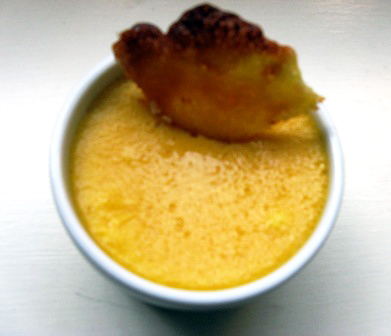
Orange Custard. Photo by Rebecca Joseph
Happy Passover! What are you cooking? Passover, even more than Thanksgiving, is a home and family holiday. Of course, there are restaurants doing Seder-inspired meals; in San Francisco, Passover at Delfina brings their Edible Seder Plate, Stoll Family Matzoh Balls, and other Italian-Jewish specialties, all much anticipated by regulars. This year, they'll be serving matzoh made by their former sous-chef, Brad Joffe, who now runs Beauty's Bagels in Oakland, source of the excellent weekend bagels at Wise Sons. (And by the way, pastrami lovers, Wise Sons is closed for Passover; they'll re-open on Sunday, April 15.)
Firefly has a delish-sounding brisket and root-vegetable tsimmes on this week's menu, along with a spring vegetable plate with matzoh kugel and yellowfoot-mushroom sauce. (And for those who don't mind a little trayf, don't worry, they've still got the shrimp-and-scallop dumplings on the menu.)
But for many of us, Passover is a time to slow down, reconnect with family and friends over dinners at home, and pay attention to what we're eating. Jewish dietary laws forbid the eating of grains during the 8-day holiday, especially anything yeasted or naturally leavened. So, no bread, no bagels, no pasta, no rice, just matzoh, a flat cracker that must be mixed and baked in less than 18 minutes, to prevent any natural rising of the dough from occurring. So, much kvetching can be heard this week from toast-lovers like myself, and, for those with a sweet tooth, a whole lot of dependance on ground nuts and matzoh meal in lieu of flour, plus whisked egg whites for fluffiness.
However, Rebecca Joseph, rabbi and owner of 12 Tribes Food, a kosher catering and prepared-meals business, looks at the holiday's restrictions with abundance in mind.
"What I suggest to people who say that they dread the holiday because they can't eat bread is to think of this as a time to celebrate freedom from habitual food choices or ways of eating that may be less than optimally healthful. Also, when we focus on all the things we can eat, especially early spring produce, then Passover meals can be really delicious and seasonal."
Joseph describes her Orange Custard recipe, below, as "a very easy dessert (no separating eggs or weird ingredients involved) that's a great break from nuts and matzoh meal. It's also parve (containing neither meat nor dairy), so it's good for people who are lactose intolerant, gluten-free and/or have nut sensitivities."
